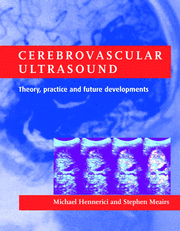Book contents
- Frontmatter
- Dedication
- Contents
- List of contributors
- Preface
- PART I ULTRASOUND PHYSICS, TECHNOLOGY AND HEMODYNAMICS
- PART II CLINICAL CEREBROVASCULAR ULTRASOUND
- PART III NEW AND FUTURE DEVELOPMENTS
- 25 Functional Doppler testing
- 26 Multigate emboli detection
- 27 Three- and four-dimensional cerebrovascular ultrasonography
- 28 Ultrasound contrast imaging
- 29 Ultrasonic thrombolysis
- Index
28 - Ultrasound contrast imaging
from PART III - NEW AND FUTURE DEVELOPMENTS
Published online by Cambridge University Press: 05 July 2014
- Frontmatter
- Dedication
- Contents
- List of contributors
- Preface
- PART I ULTRASOUND PHYSICS, TECHNOLOGY AND HEMODYNAMICS
- PART II CLINICAL CEREBROVASCULAR ULTRASOUND
- PART III NEW AND FUTURE DEVELOPMENTS
- 25 Functional Doppler testing
- 26 Multigate emboli detection
- 27 Three- and four-dimensional cerebrovascular ultrasonography
- 28 Ultrasound contrast imaging
- 29 Ultrasonic thrombolysis
- Index
Summary
Introduction
Recently, there has been increasing research and development in the field of ultrasound contrast agents because of new technologies which produce agents that are non-toxic and that persist in the circulation for the duration of a diagnostic examination. Particularly in the field of cerebrovascular ultrasound, these advances have led to a number of new applications. In patients with high-grade carotid artery stenosis, for example, contrast agents have been shown to be effective in improving diagnostic confidence. In transcranial Doppler examinations, their use can increase the technical success rate, reduce examination time, and enable colour Doppler flow imaging and pulsed Doppler systems to detect a greater number of intracranial vessels. Recent studies have documented the value of contrast imaging in characterizing intracranial aneurysms and arteriovenous malformations. New developments in ultrasound technology that exploit the oscillating properties of microbubbles may provide unique opportunities for non-invasive assessment of brain perfusion. To better understand how stabilized microbubbles produce contrast, and how ultrasound propagating parameters affect the performance of these agents, this chapter presents the physical basis of the interaction between the impinging ultrasound wave and the contrast agent. It summarizes current state-of-the-art applications for evaluation of cerebrovascular disease and describes new imaging techniques such as harmonic, pulse inversion, stimulated acoustic emission, and intermittent modes with an emphasis on their potential applications in neurosonology.
Physical principles
Ultrasound contrast agents
Commercially available contrast agents consist of microbubbles with average diameters from 3 μm to 6 μm in concentrations typically of the order of 108 microbubbles/millilitre.
- Type
- Chapter
- Information
- Cerebrovascular UltrasoundTheory, Practice and Future Developments, pp. 386 - 403Publisher: Cambridge University PressPrint publication year: 2001



